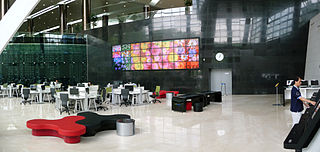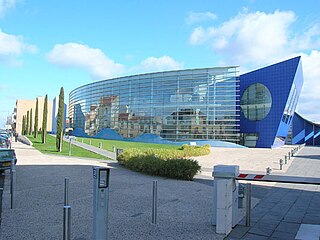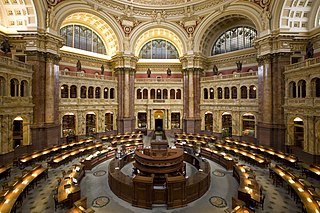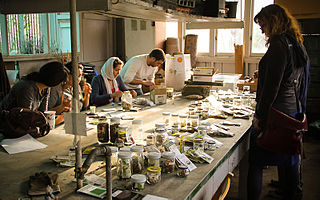 W
WAn academic library is a library that is attached to a higher education institution and serves two complementary purposes: to support the curriculum, and to support the research of the university faculty and students. It is unknown how many academic libraries there are worldwide. An academic and research portal maintained by UNESCO links to 3,785 libraries. According to the National Center for Education Statistics, there are an estimated 3,700 academic libraries in the United States. In the past, the material for class readings, intended to supplement lectures as prescribed by the instructor, has been called reserves. In the period before electronic resources became available, the reserves were supplied as actual books or as photocopies of appropriate journal articles. Modern academic libraries generally also provide access to electronic resources.
 W
WBookless libraries are public, academic and school libraries that do not have any printed books. Instead they offer all-digital collections of literary works, reading material and scientific and academic research material. A bookless library typically uses the space that would have once been used for books to offer public computers, e-readers and other technology used to consume and produce digital media. Over the last decade, driven by changes in scholarly communication, several major research libraries have successfully become bookless.
 W
WA cabinet de lecture was an establishment where members of the public in the 18th and 19th centuries could, in exchange for a small fee, read public papers, as well as old and new literary works. Individuals were able to hire books by the hour, making cabinet de lectures "precursors of modern libraries and an important and reliable market for books"
 W
WA chained library is a library where the books are attached to their bookcase by a chain, which is sufficiently long enough to allow the books to be taken from their shelves and read, but not removed from the library itself. This would prevent theft of the library's materials. However, it also led to crowding and awkwardness when readers had to stand side by side, each holding a book or clumping so they could share one. The practice was usual for reference libraries from the Middle Ages to around the 18th century. However, since the chaining process was also expensive, it was not used on all books. Only the more valuable books in a collection were chained. This included reference books and large books.
 W
WA circulating library was first and foremost a business venture. The intention was to profit from lending books to the public for a fee.
 W
WLearning commons, also known as scholars' commons, information commons or digital commons, are learning spaces, similar to libraries and classrooms that share space for information technology, remote or online education, tutoring, collaboration, content creation, meetings, socialization, playing games and studying. Learning commons are increasingly popular in academic and research libraries, and some public and school libraries have now adopted the model. Architecture, furnishings and physical organization are particularly important to the character of a learning commons, as spaces are often designed to be rearranged by users according to their needs.
 W
WLearning Resource Centre (LRC) is a term which is used in the United Kingdom to describe a type of library that exists within an educational setting such as secondary schools, further education colleges and universities. LRC can also stand for Library Resource Centre and in some cases Learning Resource Centre has been shortened to Learning Centre. Learning Resource Centres are similar to a hybrid library.
 W
WA lending library is a library from which books and other media are lent out. The major classifications are endowed libraries, institutional libraries, public libraries, and subscription libraries. It may also refer to a library or other institution that sends materials on request to another library, usually via interlibrary loan.
 W
WA multimedia library is a public institution functioning as a library, containing not only paper and electronic books, newspapers and magazines, but also multimedia materials like videos and sound recordings.
 W
WA national library is a library established by a government as a country's preeminent repository of information. Unlike public libraries, these rarely allow citizens to borrow books. Often, they include numerous rare, valuable, or significant works. A national library is that library which has the duty of collecting and preserving the literature of the nation within and outside the country. Thus, national libraries are those libraries whose community is the nation at large. Examples include the British Library, and the Bibliothèque nationale de France in Paris.
 W
WA private library is a library under the care of private ownership, as compared to that of a public institution, and is usually only established for the use of a small number of people, or even a single person. As with public libraries, some people use bookplates – stamps, stickers or embossing – to show ownership of the items. Some people sell their private libraries to established institutions such as the Library of Congress, or, as is often the case, bequeath them after death. Much less often, a private library is maintained intact long after the death of the owner. One such example is the personal library of Dr Rudolf Steiner, which has been maintained intact in Switzerland for close to a century.
 W
WA subscription library is a library that is financed by private funds either from membership fees or endowments. Unlike a public library, access is often restricted to members, but access rights can also be given to non-members, such as students.
 W
WA public library is a library that is accessible by the general public and is usually funded from public sources, such as taxes. It is operated by librarians and library paraprofessionals, who are also civil servants.
 W
WA library is a curated collection of sources of information and similar resources, made accessible to a defined community for reference or borrowing. It provides physical or digital access to material, and may be a physical location or a virtual space, or both. A library's collection can include printed materials and other physical resources in many formats such as DVDs, as well as access to information, music or other content held on bibliographic databases.
 W
WA research library is a library which contains an in-depth collection of material on one or several subjects. A research library will generally include primary sources as well as secondary sources. Large university libraries are considered research libraries, and often contain many specialized branch research libraries. Research libraries are established to meet research needs and as such are stocked with authentic materials with quality content. In most cases research libraries are attached to research institutions or organizations.
 W
WA school library is a library within a school where students, staff, and often, parents of a public or private school have access to a variety of resources. The goal of the school library media center is to ensure that all members of the school community have equitable access "to books and reading, to information, and to information technology." A school library media center "uses all types of media... is automated, and utilizes the Internet [as well as books] for information gathering." School libraries are distinct from public libraries because they serve as "learner-oriented laboratories which support, extend, and individualize the school's curriculum... A school library serves as the center and coordinating agency for all material used in the school."
 W
WA seed library is an institution that lends or shares seed. It is distinguished from a seedbank in that the main purpose is not to store or hold germplasm or seeds against possible destruction, but to disseminate them to the public which preserves the shared plant varieties through propagation and further sharing of seed.
 W
WA slide library is a library that houses a collection of photographic slides, either as a part of a larger library or photo archive, or standing alone within a larger organization, such as an academic department of a college or university, a museum, or a corporation. Typically, a "slide library" contains slides depicting artwork, architecture, or cultural objects, and is typically used for the study, teaching, and documentation of art history, architectural history, and visual culture. Other academic disciplines, such as biology and other sciences, also maintain image collections akin to slide libraries. Corporations may also have image libraries to maintain and document their publications and history. Increasingly, these types of libraries are known as "Visual Resources Collections," as they may be responsible for all "visual" materials for the study of a subject and include still and moving images in a variety of physical and virtual formats. They may contain:35mm slides lantern slides mounted study photographs born digital images 35mm, 8mm film
 W
WA subscription library is a library that is financed by private funds either from membership fees or endowments. Unlike a public library, access is often restricted to members, but access rights can also be given to non-members, such as students.
 W
WA special library is a library that provides specialized information resources on a particular subject, serves a specialized and limited clientele, and delivers specialized services to that clientele. Special libraries include corporate libraries, government libraries, law libraries, medical libraries, museum libraries, news libraries. Special libraries also exist within academic institutions. These libraries are included as special libraries because they are often funded separately from the rest of the university and they serve a targeted group of users.
 W
WA subscription library is a library that is financed by private funds either from membership fees or endowments. Unlike a public library, access is often restricted to members, but access rights can also be given to non-members, such as students.
 W
WA tool library is an example of a Library of Things. Tool libraries allow patrons to check out or borrow tools, equipment and "how-to" instructional materials, functioning either as a rental shop, with a charge for borrowing the tools, or more commonly free of charge as a form of community sharing. A tool library performs the following main tasks:Lending: all kinds of tools for use in volunteer projects, facility maintenance and improvement projects, community improvement events, and special events. Advocacy: for the complete and timely return of all borrowed tools, to guarantee the long-term sustainability of available inventory. Staff also seeks compensation for lost tools and tools returned late. Maintenance: performing routine maintenance and repairs on all equipment to ensure good condition and to extend the lifespan of the inventory. This function is typically performed by volunteers and community service workers. Education: Some tool libraries also provide educational classes. Vancouver Tool Library and Community Access Center (VTLCAC) in Vancouver, Washington offers individual project support and classes on woodworking and basic car maintenance
 W
WA toy library lends or hires out toys, puzzles, and games, functioning either as a rental shop or a form of family resource program. Toy libraries offer play sessions for families and a wide range of toys appropriate for children at different stages in their development. Toy libraries provide children with new toys every week or two, saving parents money and keeping children from getting bored. Popular in the French-speaking world, toy libraries are called ludothèques.